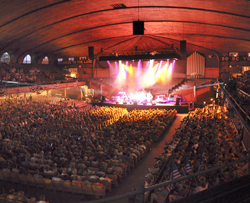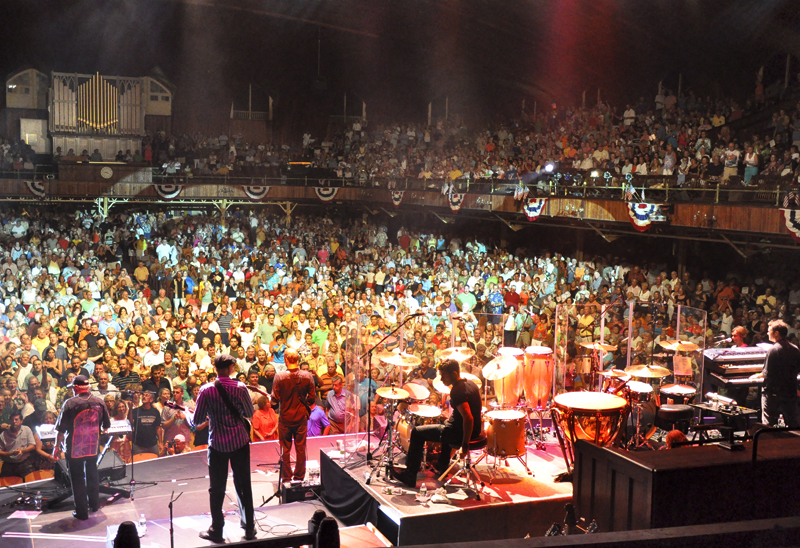
ACIR also placed several proprietary, in-house branded enclosures at the Great Auditorium, including six double 18-inch subwoofers for low-frequency support. These were arranged three cabinets per side and ground stacked on the main floor adjacent to the edge of the stage.
For stage monitors, ACIR used 20 of its model 152 enclosures – two for choir fills, another two for outfills plus an additional 16 available as required for both concerts and worship services. Power for these systems was provided by a combination of Crown Audio Macro-Tech MA-3600VZ and d&b audiotechnik D12 amplifiers. There were no sidefills due to line of sight considerations.
The delay system, with both left-right arrays positioned three-quarters of the way back into the room and flown 27 feet above the main floor, focused on the balcony areas.
For this application, the ACIR crew flew WorxAudio Technologies X3-P self-powered line arrays. These “all-in-one” compact enclosures incorporate three modules, each with a medium format, 1-inch exit compression driver paired with dual 8-inch cone transducers.
Tannoy V12 installation loudspeakers provided the under-balcony fills. A total of six enclosures – two to each zone – were split among three zones.
Management, Consoles & Mics
At the conclusion of each Saturday evening concert, which included performances by the Oak Ridge Boys, The Music of Abba, contemporary Christian artist Steven Curtis Chapman, Air Supply, and others, the front extension to the stage/altar area needed to be pulled in order to prepare the venue for Sunday morning services.

Similarly, the front of house console was pulled and, in its place, the church sound crew placed its own mixing console. This situation required the ACIR crew to devise an effective means of swapping consoles while retaining the room tuning and delay settings of the loudspeaker systems.
“Hugh Sarvis of WorxAudio Technologies, Tom Young, and I spent considerable time adjusting the equalization and delay settings for this room,” explained DiBona. “The delay clusters, under-balcony fills – everything – were EQ’d precisely and time-aligned very carefully, measuring all the way back to where the pipe organ resides, since we figured this would typically be where the drum sets would be positioned for most shows.
“Hugh brought in his TEF analyzer and worked closely with Tom to utilize ETCs (energy time curves) to precisely set delay zones, while Tom programmed them into a Yamaha DME24N digital mixing engine, which served as the loudspeaker management system. The DME24N ensured the system’s sound quality remained consistent for both Sunday services and the concerts.”
“All the various loudspeaker zones were connected to this processor,” DiBona continued. “This was a good starting point for any engineer coming into this space, and the arrangement also enabled both ACIR and the church crew to maintain a consistent room sound from week to week. The front of house console could quickly be disconnected and the church’s sound crew then made a simple connection into the processor with their board. Everything else remained in place.”
